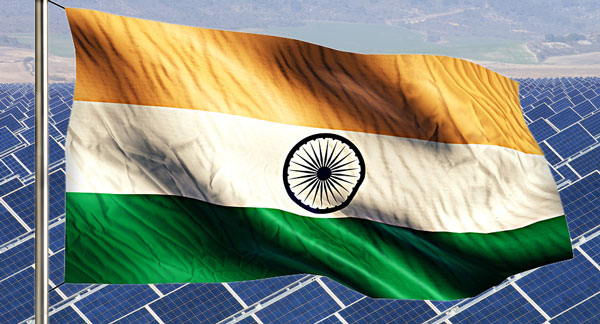As we in Australia struggle with a federal government attitude to renewables halfway between apathy and utter neglect, things continue apace on the sub continent. Indeed India’s renewable energy policy is now primed to make the country one of the world’s leaders in alternative energy.
Prime Minister Narendra Modi has made the development of alternative energy — such as solar power — a priority since his election in mid 2014. In the latest phase of his government’s exciting policy development, the Indian government has announced the creation of a federation of 50 solar power-rich nations with India at the head of the grouping.
India as a global solar superpower? Is this overly ambitious? Not if you listen to Piyush Goyal, India’s Power, Coal and New and Renewable Energy Minister in his statement to the press last week.
“We are going to work with the World Economic Forum, IREDA ( Indian Renewable Energy Development Agency) to build a consortium of renewable energy countries in the days ahead,” he said. “We will work together to make India renewable energy capital of the world.”
Goyal was echoing the determination of his prime minister in moulding India’s energy policy towards renewables.
Jobs will be one of the major beneficiaries of Prime Minister Modi’s plan to create 100 gigawatt of solar energy by 2022 with an estimated one million people employed in the industry according to Natural Resources Defense Council (NRDC).
“Prime Minister Modi’s clean energy plan creates enormous potential for India’s booming population. It provides job opportunities and access to electricity that will power rapidly growing cities and villages,” said Anjali Jaiswal, Director of NRDC’s India Initiative.
PM Modi has described the narrowing of the gap between traditional power and renewable energy as a “gamechanger” and the reason behind the massive investment in the sector in his country.
India faces a number of challenges before it can become the head of a federation of solar-power rich nations. As well as the current reliance on coal-fired plants in many states, there is the lack of a tradition of renewable energy in the country. Indeed India has only about 3 gigawatt solar energy capacity out of a total clean energy output of 33 gigawatts.
However with a huge economy, coupled with an energetic policy by the federal government, lowering solar power costs, an emphasis on jobs and encouragement of overseas investment, you have the ingredients of India’s renewable energy sector of the future. Let’s hope that if the world’s biggest democracy is successful in forming a federation of 50 solar rich countries they include us as well!


 RSS - Posts
RSS - Posts



Yes, Australia is behind, way behind. How can we want to develop solar energy when we are only interested in being one of the worlds largest exporter of CO2 (coal) ???
john Nielsen, Silkwood, Qld.
Neither the Indian sub-continent, its manufactured products, its culture nor its population have ever been high on the list of things I admire, consequently I’m amazed to read the country far surpasses Australia in acceptance of alternative energy. If anything, this should be a wake-up call to the clowns we elect, mind you given the prevailing political attitude as expoused by knuckle-dragging neanderthals the big-eared wabbott & ex QLD deputy premier Seeney (whose biggest claim to fame was banning any mention of AGM caused sea level rising), enlightenment has yet to dawn.
Does this really underline just how far we are behind folks?
Yes, our governments don’t want us to have solar power. They, the feds and states are lobbied by the fusel fuel mob to restrict us having solar power. Here in my area are 3 installations waiting for Ergon (the Queensland government utility grid) to approve the installation. Some of these people have waited more than 5 weeks, and still no reply. I have suggested to them to purchase batteries and disconnect from the grid altogether as this is what I myself will do. In my case Ergon will loose two accounts. If these government agencies were private companies with competition, they wouldn’t be in business for long, but they are government monopolies and as such they can do what they want, and so can we the customers.
john Nielsen, Silkwood. Qld.
Our politicians are total philistines beholden to big business. A year or so back I had an interest in building a small non-profit community solar farm. I discovered a special unit within the Department of Energy & Water (forget the minister although I’ve been to his office in Caloundra several times) titled ‘renewable energy office’.. After the obligatory few hours of being stuffed around I spoke to the head scherang believing that as head of the renewable energy office he’d be overjoyed to assist with my project. Yes well, the clown advised me that since it was highly likely to be detrimental to the profitability of state government owned corporations Energex / Ergon / Powerlink, his office would do its utmost to ensure the project never got off the ground.
Shocking YesMinister. You’re excellent project should have been accepted with open arms.
I haven’t tried the same trick with the new (ALP( Energy Minister but intend to do so as time permits providing the party survives its present turmoil. In the immediate future I have a few other axes to grind with the new Attorney General.
Correct John. Indeed battery storage may well be the future for alternative energy. Maybe five to six years before it becomes fully viable? Or less?
Batteries are at least halfway affordable right now providing one doesn’t go totally overboard. I have 4 x 280ah chinese AGM deep cycle batteries that cost $2000 and expect to get 8 years out of them. Within a few years we can expect to see current style lithium cells drop to half present price and then there is the solid state version looking extremely promising with VW / Porsche / Audi planning on adopting the technology for their EVs.